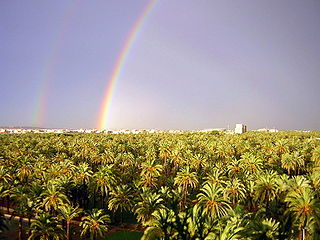 W
WAgriculture in Spain is important to the national economy. The primary sector activities accounting for agriculture, husbandry, fishing and silviculture represented a 2.7% of the Spanish GDP in 2017, with an additional 2.5 % represented by the agrofood industry.
 W
WA braña is a seasonal pasture in the Cantabrian Mountains of northwest Spain, particularly in Asturias, Cantabria, and northern León. Brañas support several types of transhumance and can be used during different periods in the year, though the word is most often associated with summer usage.
 W
WBujeo is a type of soil found on the countryside of Andalusia, mainly the area of the Guadalquivir valley.
 W
WThe Cachena is a breed of triple-purpose cattle from Portugal and Galicia, Spain. In Portugal, there is also the similar but larger cattle breed known by the name, Barrosão or Barrosã. Cachena and Barrosã are sometimes considered variants of the same race.
 W
WA dehesa is a multifunctional, agrosylvopastoral system and cultural landscape of southern and central Spain and southern Portugal; in Portugal, it is known as a montado. Its name comes from the Latin 'defensa' (fenced) referring to land that was fenced, and usually destined for pasture. Dehesas may be private or communal property. Used primarily for grazing, they produce a variety of products, including non-timber forest products such as wild game, mushrooms, honey, cork, and firewood. They are also used to raise the Spanish fighting bull and the Iberian pig. The main tree component is oaks, usually holm and cork. Other oaks, including melojo and quejigo, may be used to form dehesa, the species utilized depending on geographical location and elevation. Dehesa is an anthropogenic system that provides not only a variety of foods, but also wildlife habitat for endangered species such as the Spanish imperial eagle.
 W
WFor the most part, the history of forestry in Spain was one of increasing deforestation. Wood long was the main source of energy. It was in the 20th century when efforts to revert the trend were taken, increasing the forested area in the country from then on.
 W
WThe intensive agriculture of the province of Almeria, Spain, is a model of agricultural exploitation of high technical and economic yield based on the rational use of water, use of plastic greenhouses, high technical training and high level of employment of Inputs, on the peculiar characteristics of the environment. The greenhouses (invernaderos) are located between Motril and Almeria. Especially the area of El Ejido is well known to be an agricultural hotspot.
 W
WManzanilla olives ("man-zah-nee-ya") or Manzanillo, also Manzanilla de Sevilla, originally from the area of Seville, Spain, are sometimes referred to as Spanish olives but along with Arbosana, Arbequina, Cacereña, Hojiblanca, Empeltre, and Gordal there are over two hundred varieties grown in Spain as well as other areas.
 W
WThe Palmeral or Palm Grove of Elche is the generic name for a system of date palm orchards in the city of Elche, Spain. It was planted in Roman times and underwent modifications in the medieval period under Islamic and Christian rulers. The Roman empire introduced water management techniques to Elche, but the 10th c. Islamic Caliphate of Córdoba and later rulers of Al-Andalus planted palm groves and garden-estates in huertos. Islamic rulers also constructed the largest canal system sections in Elche. In the 13th century Christian rulers conquered Elche and expanded the canal system. Industrialization and urban sprawl contracted the Palmeral in the late 19th and 20th century. The Spanish national government and Valencian regional government enacted legislation to protect the Palm Grove. In 2000, UNESCO designated the Palmeral a World Heritage Site, but climate change, pests, and disease threaten the site. The Palmeral includes a National Artistic Garden, Palm Grove Museum, Route of El Palmeral, and Municipal Park.